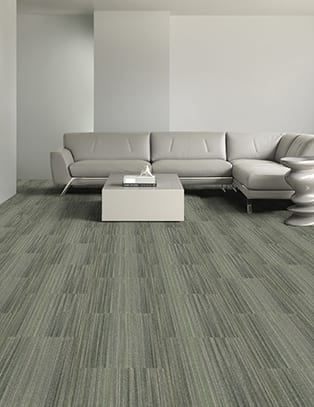Carpet Tiles
Carpet tiles, also known as modular carpet squares, are an increasingly popular flooring solution, especially in high-traffic areas. Typically measuring 24 inches by 24 inches, these tiles consist of carpet fibers bonded to a dense, rubber-like base—often vinyl—to ensure dimensional stability. This stability prevents the tiles from expanding or contracting due to fluctuations in temperature or humidity.
Quarter Turned Carpet Squares.

Monolithic Lay Carpet Tile.
Advantages of carpet tiles.
- Ease of Installation: Carpet tiles are straightforward to install, making them a convenient choice for both residential and commercial settings.
- Durability: Designed to withstand significant wear and tear, they are well-suited for areas with heavy foot traffic.
- Reduced Waste: The modular nature of carpet tiles often results in less material waste during installation compared to traditional broadloom carpets
- Simplified Maintenance: Individual tiles can be replaced if they become stained or damaged, eliminating the need to replace the entire carpeted area.
- Flexible Installation: For complex projects, carpet tiles allow for staged installations, offering greater flexibility than broadloom carpets.

Ashlar Style Carpet Tile.

Brick Lay Carpet Tile.
Cost Considerations
While the per-square-foot cost of carpet tiles may be slightly higher than that of traditional broadloom carpets of similar quality, several factors contribute to their cost-effectiveness:- Material Efficiency: The installation process typically results in less waste, optimizing material usage.
- Targeted Replacement: The ability to replace individual tiles extends the overall lifespan of the flooring, potentially reducing long-term costs.
Design Versatility
Carpet tiles offer a range of design possibilities through various installation patterns, including:- Quarter Turn: Each tile is rotated 90 degrees relative to adjacent tiles, creating a subtle, textured pattern.
- Monolithic: Tiles are installed in the same orientation, resulting in a seamless, uniform appearance:
- Ashlar: Tiles are laid in a staggered pattern, similar to traditional brickwork, offering a dynamic visual effect.
- Brick Lay: Mimicking the classic brick pattern, this layout provides a timeless and structured look.